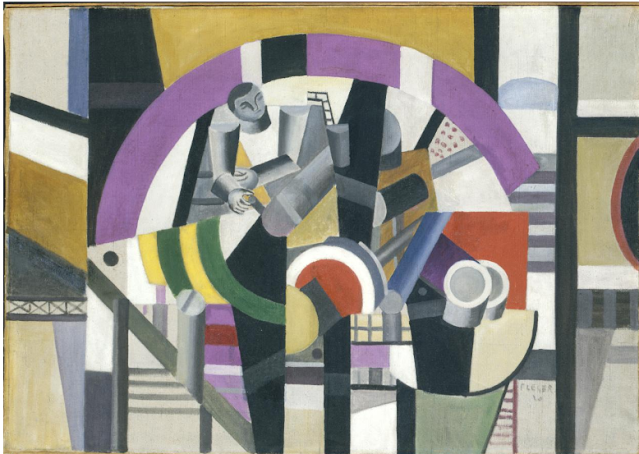Grant Wood, "January"
This week I am taking us briefly back to winter, but I think for good reason, so stay with me. I want to review this painting slightly different than normal.
Our artist is Grant Wood (1891-1942). As many Americans remember, Wood was an American artist who was considered a Regionalist because most of his subject matter was drawn from his native state, Iowa. His most famous painting is American Gothic, an image of a farmer and his daughter which is part of the permanent collection of the Chicago Art Museum. That painting appears one thing on the surface, but deeper examination uncovers a more complex artistic statement. I believe the same can be seen in our painting for this week.
What we have here are: stylized haystacks, uniformly spaced, and each exactly draped with a layer of snow. Notice the snow covers the whole top, the uncovered side is in shadow, with only a sliver of light on the right. Our center of attention is the front stack where a triangle has been ripped open and tiny footprints are seen coming out and running out of sight. Finally, take note that the rear of the landscape, the sky, is very dark with the foreground light. Shadows indicate the light source is off the right side of the scene.
Now the tough part: imagine the haystacks as people. Imagine Wood is telling us something about human nature - not nature in winter. Then, who or what has escaped, and if the stacks are humans, (or human families) what does the snow represent? And, what about the light, is it increasing, or going out, and what does that mean?
Many years ago I lead an adult group in a painting project where we pretended kitchen pitchers were human and before painting, arranged them in "families". They were then situated to portray feelings. For example a pitcher separated from a group had been disinherited; pitchers touching were loving. Has Grant Wood done something similar here? I like to think so.
We now have the benefit of examining Wood's Iowa life in hind sight. We discover that he was a closet homosexual existing in a strict, conservative environment. Realizing this, it becomes easier to look into this painting to understand it's possible real meaning.
To accept my thesis for this week, is to discover Art can have many layers. It's not essential to know Wood's personal life, only helpful. How many other works of Art, by many other artists, have meaning beyond the surface image? Honestly, it is this quality that raises a painting into the wider world of Art, and therefore, a painter into a true Artist.
The title of our work this week is "January" It was executed between 1940 and 1941, a year before Wood's death. It is an oil on masonite, measuring 26.3 inches high, 32.4 inches across. It is part of the permanent collection of the Cleveland Museum of Art, Cleveland, Ohio.
Make Art a part of your life, it's a beautiful thing to do.




Grant’s work often seems to have more beneath the surface than what he depicts in his paintings. The “January “ sky seems eerie and ominous. I disagree with the animal tracts. They are rabbit tracks going into the haystack for safety and comfort, just as he conceals himself. I admire his perseverance, as he was challenged by the European art versus regional, worked through the great depression, wasn’t always received favorably by WPA art, and tried to not reveal his sexual orientation. He always stayed true to his style. What are the little figures at the lower edge? Critter, or posts? The line of tracks on the left side don’t tell us whether it’s the beginning or end. They just stop. Great painting. Your lessons on “pitchers” and emotions was one of my favorites!!! Char
ReplyDeleteYou are so right, Char! Why didn't I think of the possibility of the haystack offering safety and comfort?! Of course, both ideas are possible, which simply proves we come to a work of Art from our individual perspectives. We interpret the artist's statement as meets our own thoughts and feelings at a particular moment.
DeleteI also wondered about the little figures at the lower edge. I couldn't decide, either, but they do add a little variety and balance to that corner.
test
ReplyDelete